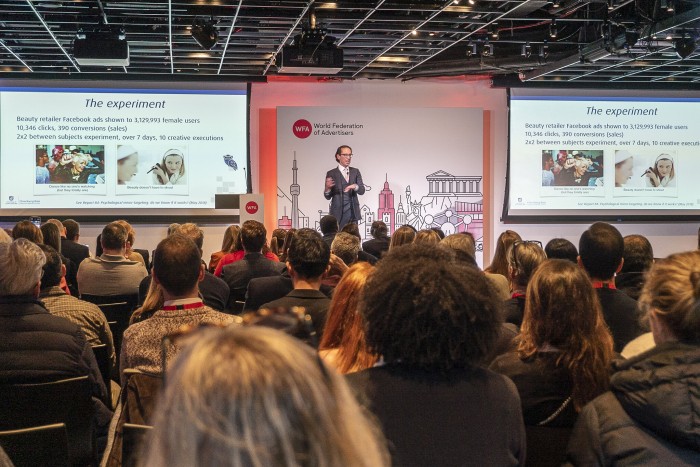Get analysis, insight & opinions from the world's top marketers.
Sign up to our newsletter.
Matt Green, Director of Global Media Services, reflects on WFA's work on marketing effectiveness over the past year and what brands need to keep in mind to build a culture of effectiveness.
In recent months, we at WFA have been on a mission. A mission to help our various communities accelerate within what they tell us is their number one priority area: marketing effectiveness.
And given that this is a challenge that concerns multiple departments, we’ve sought to unite teams physically in our ‘Forum Connect’ sessions. To date, these have been held in Amsterdam, Singapore and, most recently, New York. We’ve heard from around 500 individual marketers and have been exposed to at least 20 member cases - in addition to stimulus from some of the biggest effectiveness thinkers of our time, including Mark Ritson and Byron Sharp.
 Professor Byron Sharp speaking at WFA's Forum Connect New York on 16 November 2023.
Professor Byron Sharp speaking at WFA's Forum Connect New York on 16 November 2023.Having been on what might be considered a client-only international effectiveness roadshow, it’s fascinating to see that there’s still a wide variety of approaches, practices and theories being pursued within an area that some consider a science. But, according to our recent benchmarking study, few clients score themselves above 6 out of 10 for effectiveness. With so much established science to be found, should we not all be hitting it out of the park?
The answer is easy enough to find. In our study, written in collaboration with Ebiquity and IPA, we define effectiveness as a four quadrant “process of improving business performance from marketing activities, made easier and more impactful by people; data, tools and measurement; and a strong and clear focus”.
In summary, we’re talking about something which touches much of the marketing function (and beyond) and, to do well, requires considerable organisational alignment. Companies that are good at effectiveness tend to focus on the establishment of a ‘culture of effectiveness.’ That means prioritising the development of people and capabilities as much as science and data. And we’ve seen wonderful examples of this from our Forum Connect meetings, with cases from companies including ABInBev, Haleon, Kellanova, L’Oréal, Nestlé, Philips, Reckitt, Sanofi and others.
There is, of course, a strong data, tools and measurement side to this story. We’ve seen that cross-channel measurement tools that are more predictive in nature are in short supply. This is not new news but we are reaching a crescendo, where a cumulative set of issues increasingly demand an industry response.
Based on what we found in our study and what we’re hearing across three continents, we think there are four key steps for clients and for the industry:
Ultimately, all of the above priorities have to demand a collaborative industry response but none more so than tools which are a common pain-point for advertisers.
That’s why we’ve become preoccupied with delivering a new approach for today’s market, and that of the future. We want to start with one of the industry’s most foundational effectiveness studies (Reach and Frequency), but with a line of sight to other measures.
Having first developed a ‘North Star’ articulation of advertiser needs, in participation with partners from across the industry, we’ve developed the Halo CMM Framework.
Halo is an innovative set of open-source technologies, based around the “revolutionary” concept of ‘Virtual Persons’. Virtual people are not real people, but they can represent real audiences and populations and, through the application of further privacy-preserving techniques, can be made private. These tools offer a global foundation that can be adapted for the media measurement needs of local markets.
Measurement is a local business and we’re excited to see how two pioneering local markets from WFA’s network of associations (ISBA/Origin in the UK and ANA in the US) can breathe life into the Halo Framework. Exciting progress is being made and we’re looking forward to seeing other advertiser-led coalitions taking shape elsewhere in the world. And beyond that, we’re keen to see how Halo can be reconfigured to serve other effectiveness purposes.
So our mission to advance effectiveness measurement continues along a dual track. We will continue to showcase some of the best examples of clients building effectiveness cultures. And we will continue to work with the industry on the development of advertiser-driven effectiveness tools, for local deployment.
In many respects we’re at the very beginning of our journey. But we can see where we’re going.
This article was also published in The Media Leader on 27 November 2023.
For more information or questions, please contact us

